Abstract
Recent studies suggest that oxygen free radicals may mediate postischemic myocardial dysfunction ("stunning"), but all the evidence for this hypothesis is indirect. Thus, we used electron paramagnetic resonance (EPR) spectroscopy and the spin trap, alpha-phenyl N-tert-butyl nitrone (PBN), to directly investigate whether free radicals are produced after a 15-min coronary artery occlusion and subsequent reperfusion in 30 open-chest dogs. After intracoronary infusion of PBN, EPR signals characteristic of oxygen- and carbon-centered radical adducts were detected in the venous blood draining from the ischemic/reperfused vascular bed. The myocardial release of PBN adducts began during coronary occlusion but increased dramatically in the first few minutes after reperfusion. After this initial burst, the production of radicals abated but did not cease, persisting up to 3 h after reflow. The EPR spectra (aH beta = 2.67-2.79 G, aN = 14.75-15.00 G) were consistent with the trapping by PBN of secondary oxygen- and carbon-centered radicals, such as alkoxy and alkyl radicals, which could be formed by reactions of primary oxygen radicals with membrane lipids. There was a linear, direct relationship between the magnitude of PBN adduct production and the degree of ischemic flow reduction. Recovery of contractile function (measured as systolic wall thickening) after reperfusion was greater (P less than 0.05) in dogs given PBN than in controls. This study demonstrates that reversible regional myocardial ischemia in the intact animal is associated with prolonged free radical generation, and that the intensity of such generation is related to the severity of ischemia. The results provide direct evidence to support the hypothesis that reactive oxygen metabolites contribute to the persistent contractile dysfunction (myocardial stunning) observed after brief ischemia in vivo.
Full text
PDF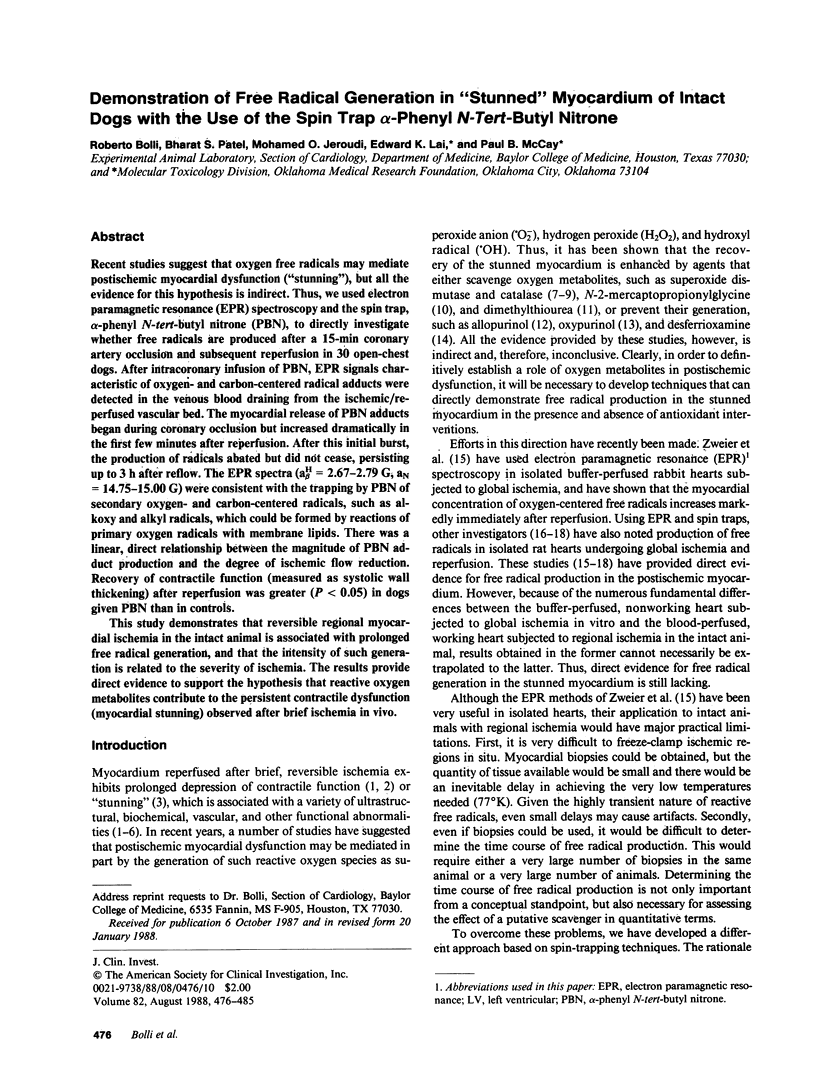
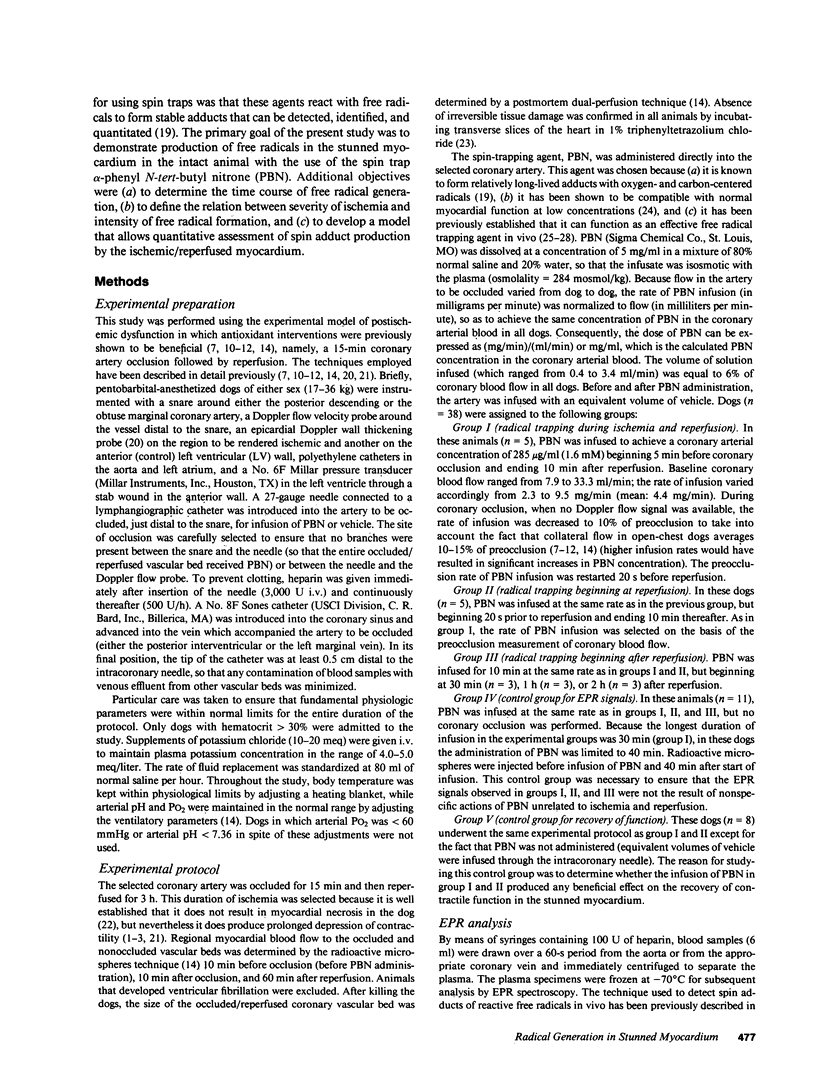
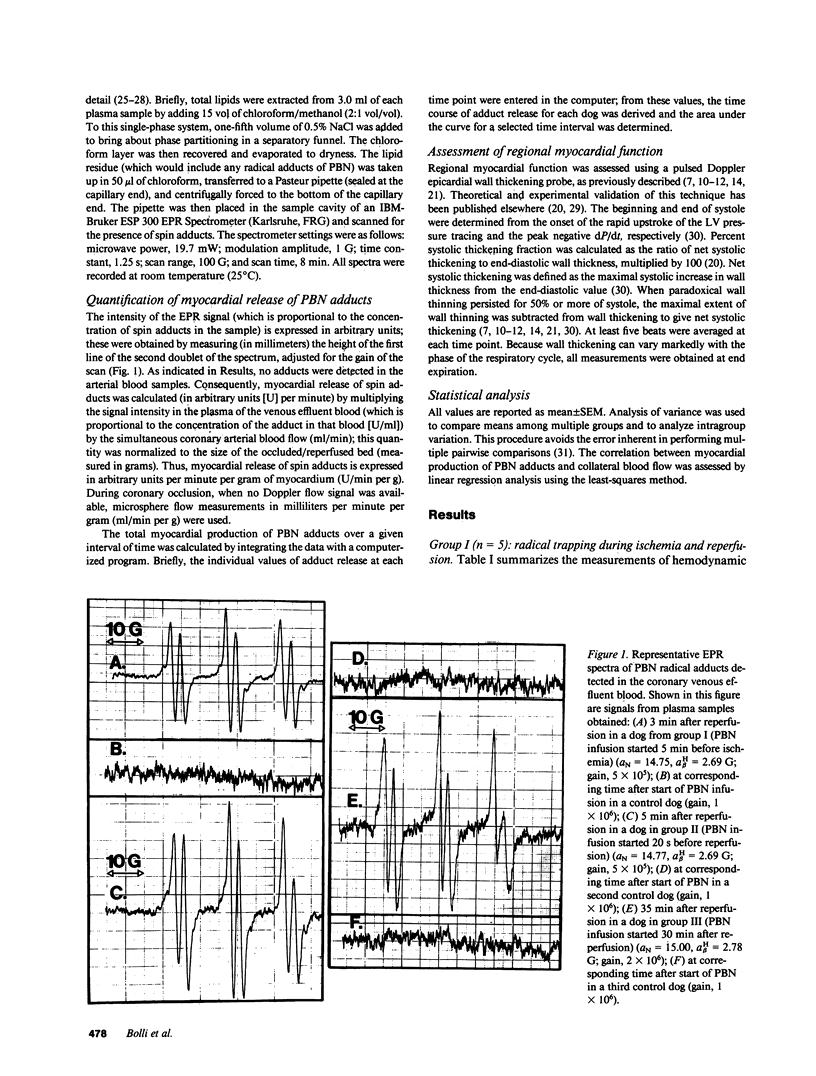
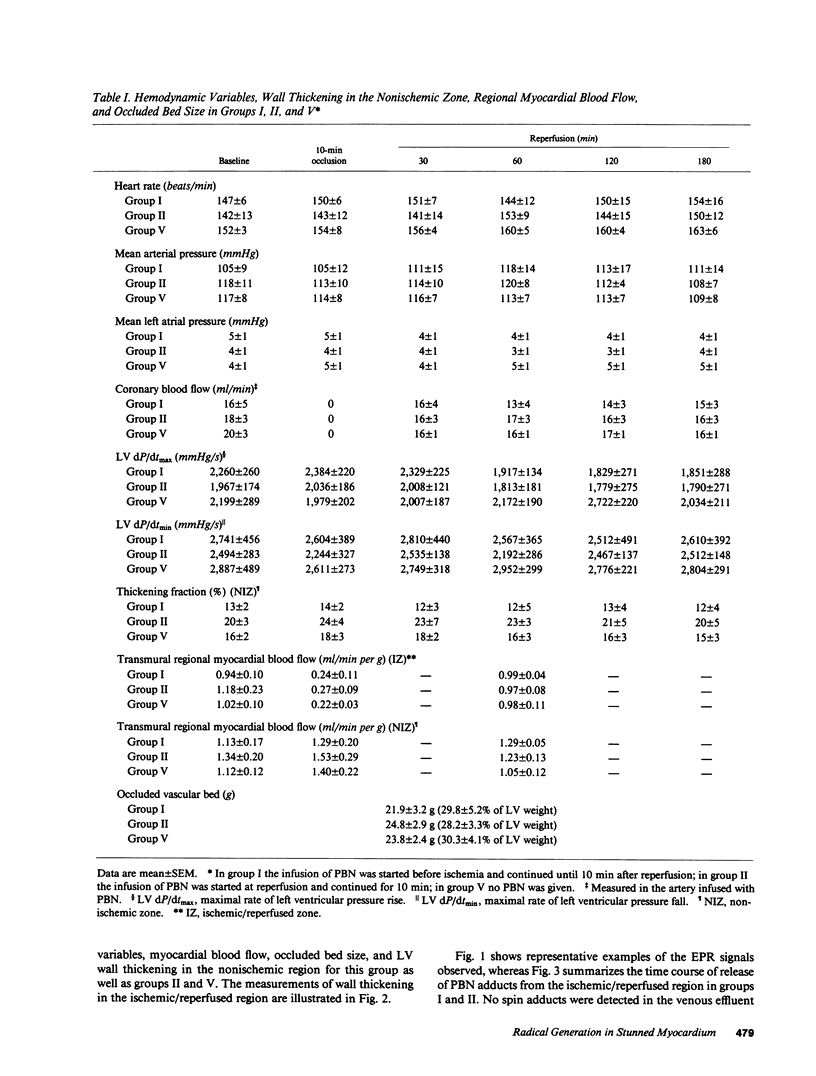
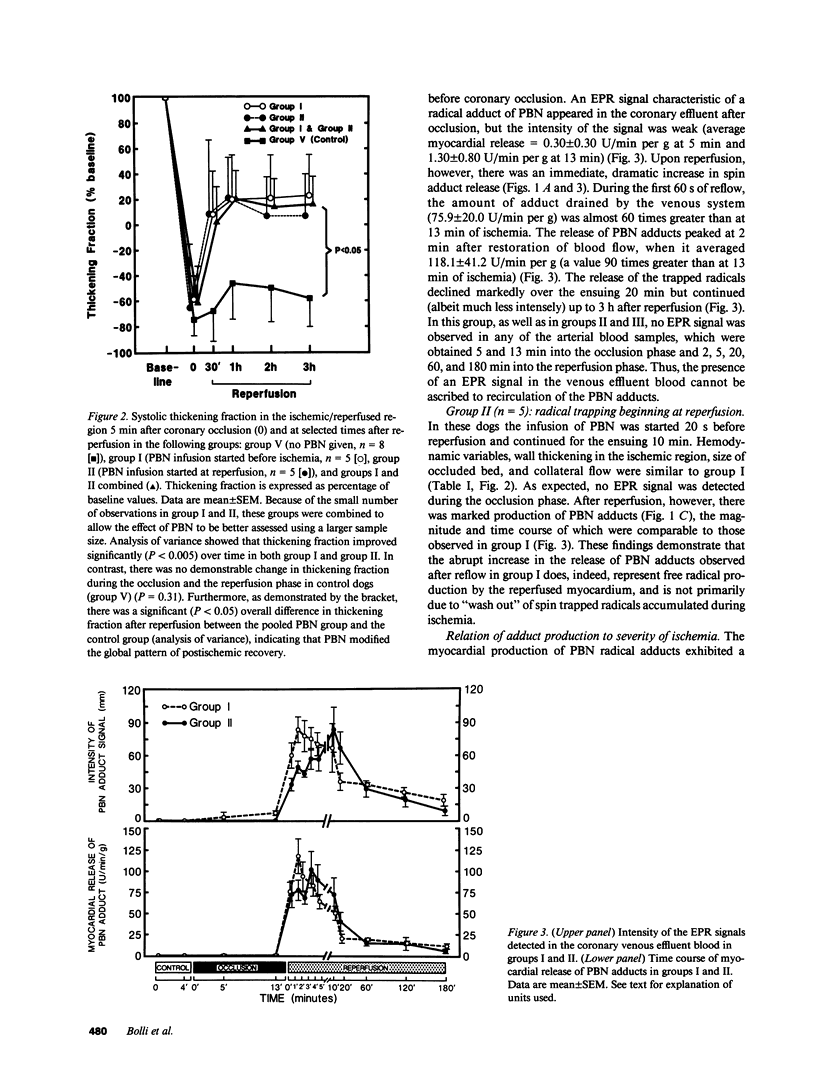
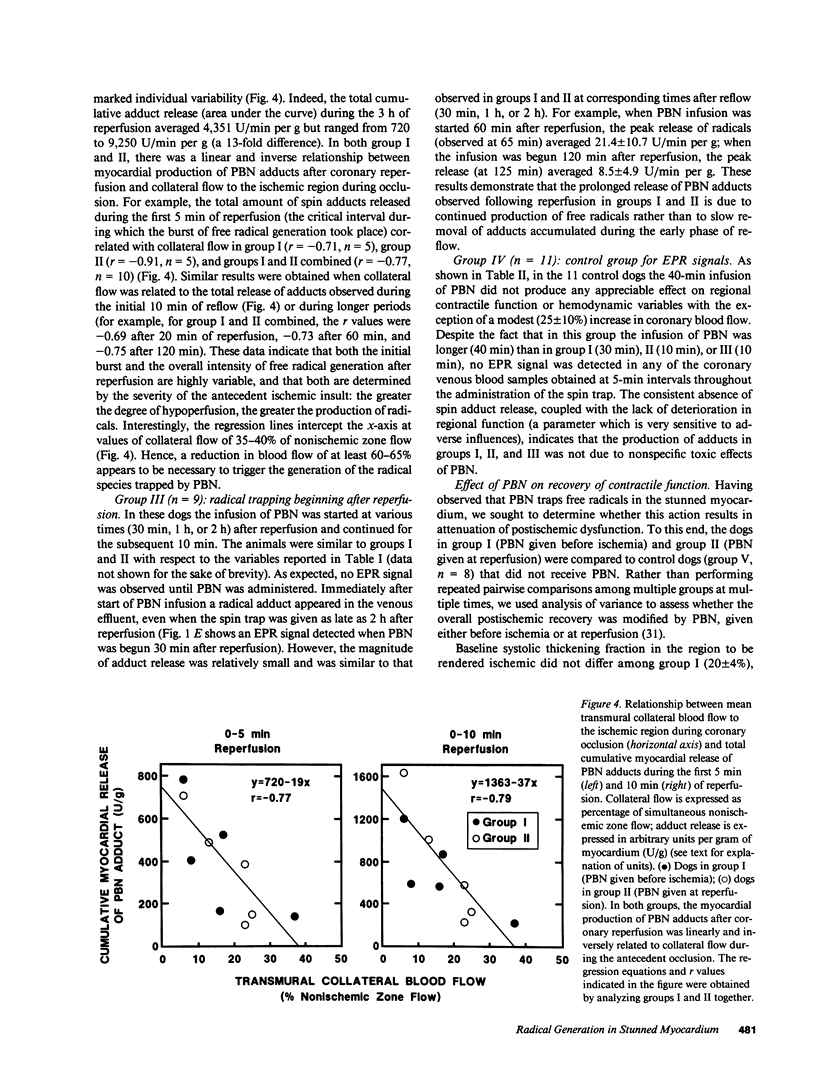
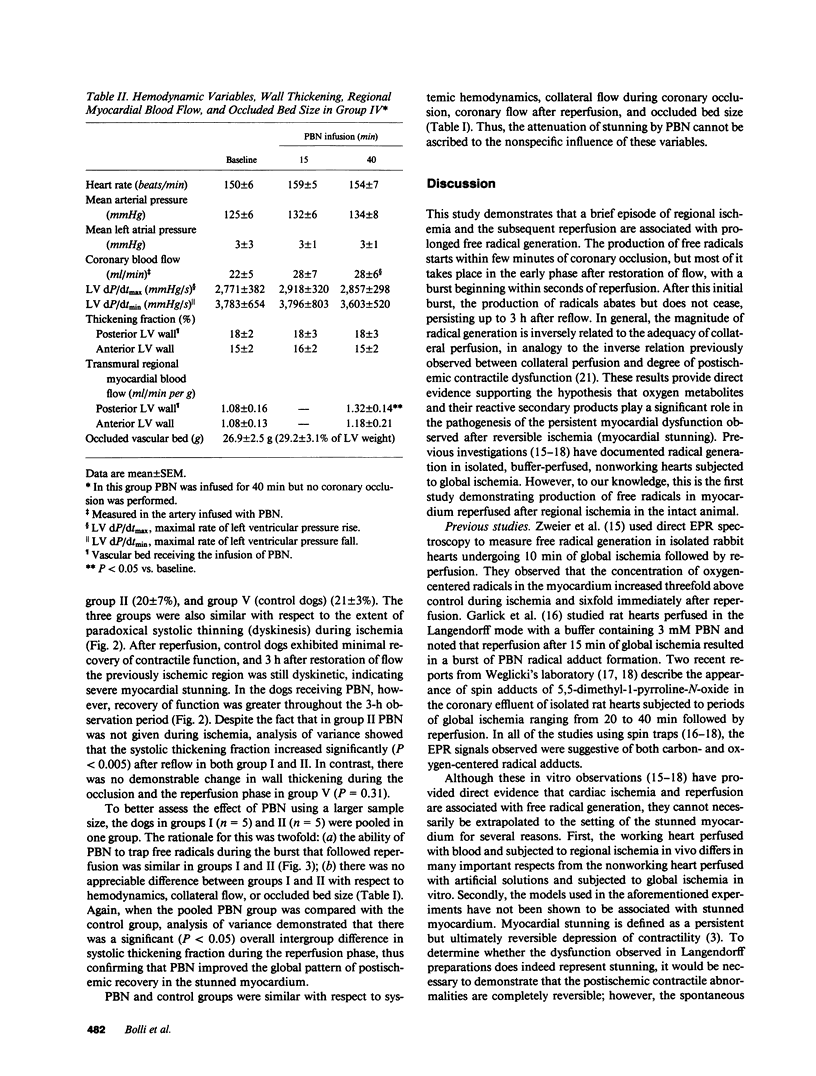
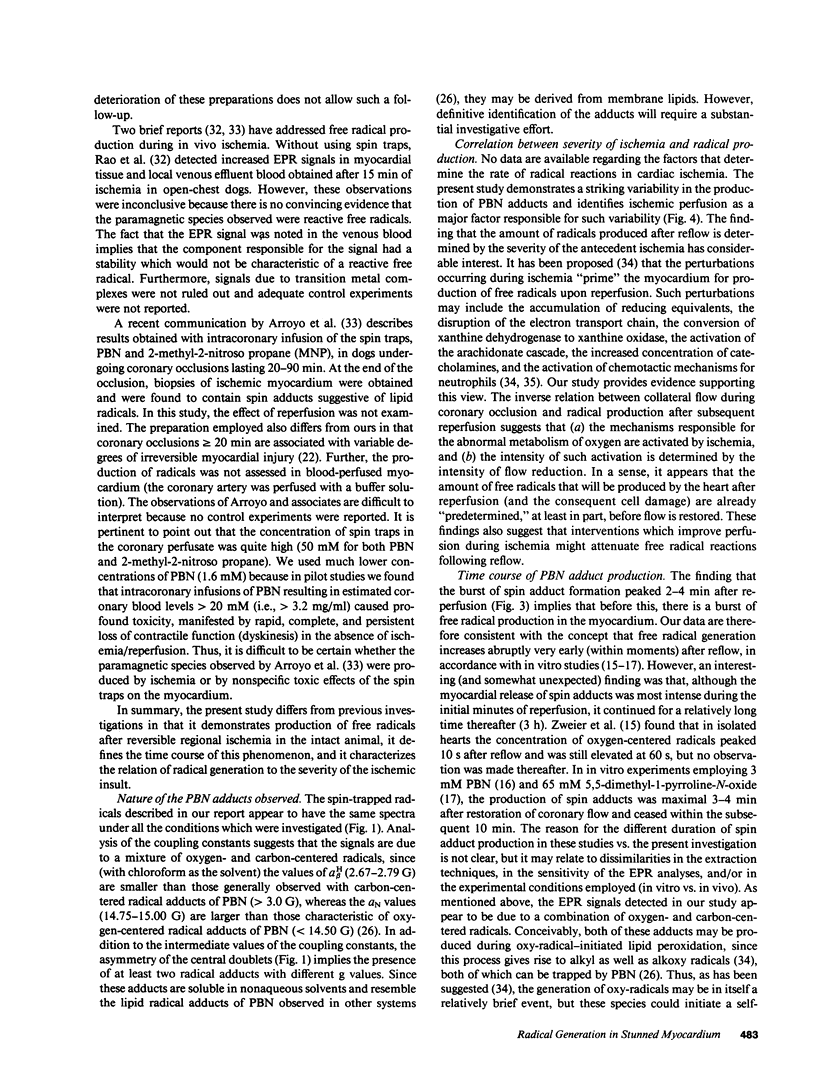
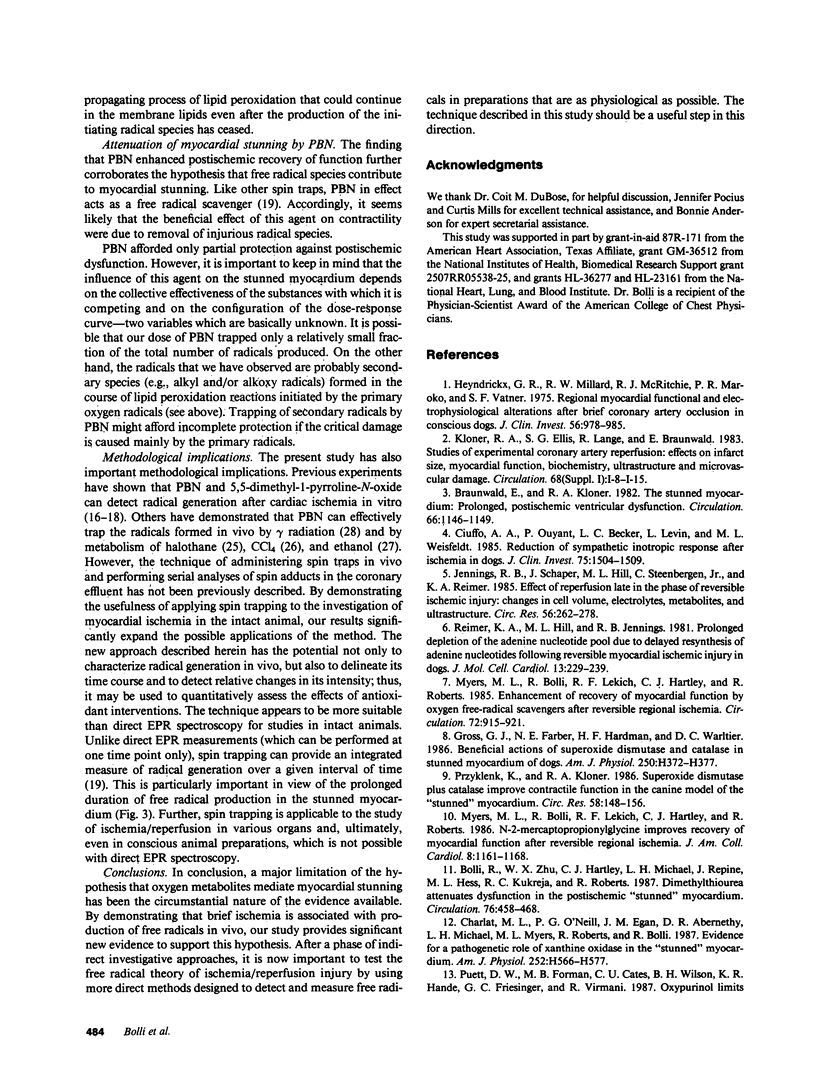
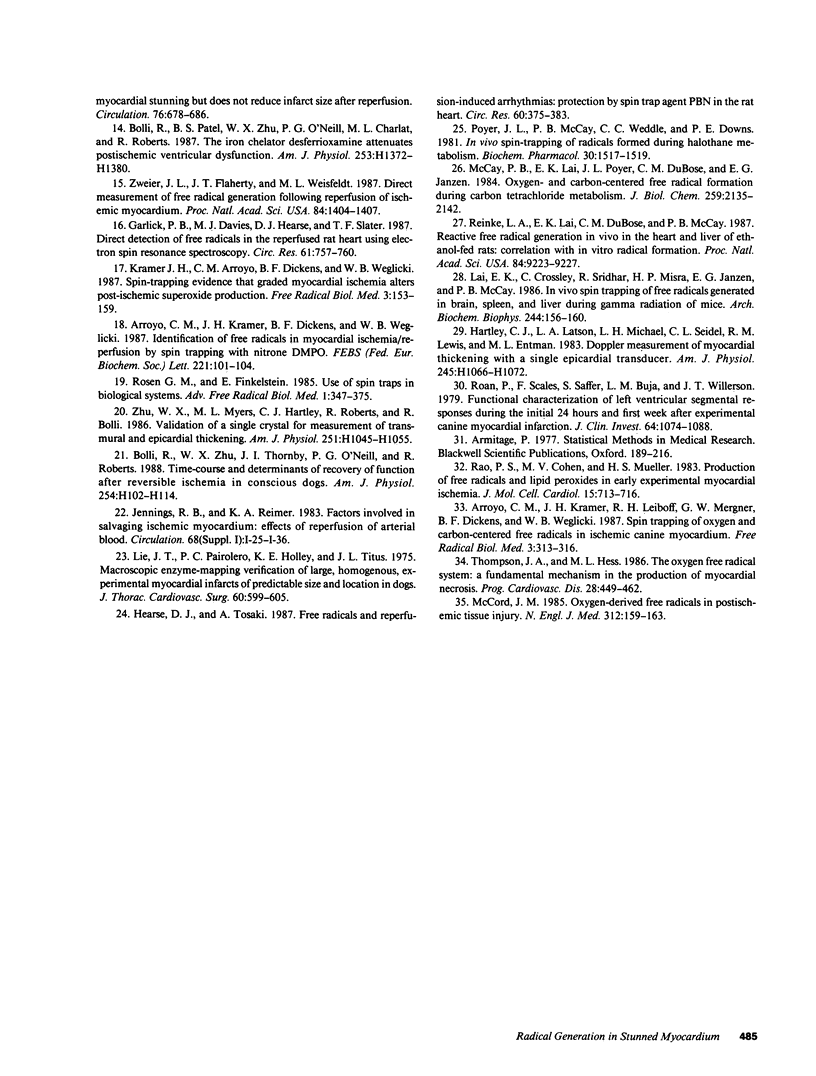
Selected References
These references are in PubMed. This may not be the complete list of references from this article.
- Arroyo C. M., Kramer J. H., Dickens B. F., Weglicki W. B. Identification of free radicals in myocardial ischemia/reperfusion by spin trapping with nitrone DMPO. FEBS Lett. 1987 Aug 31;221(1):101–104. doi: 10.1016/0014-5793(87)80360-5. [DOI] [PubMed] [Google Scholar]
- Arroyo C. M., Kramer J. H., Leiboff R. H., Mergner G. W., Dickens B. F., Weglicki W. B. Spin trapping of oxygen and carbon-centered free radicals in ischemic canine myocardium. Free Radic Biol Med. 1987;3(5):313–316. doi: 10.1016/s0891-5849(87)80037-0. [DOI] [PubMed] [Google Scholar]
- Bolli R., Zhu W. X., Hartley C. J., Michael L. H., Repine J. E., Hess M. L., Kukreja R. C., Roberts R. Attenuation of dysfunction in the postischemic 'stunned' myocardium by dimethylthiourea. Circulation. 1987 Aug;76(2):458–468. doi: 10.1161/01.cir.76.2.458. [DOI] [PubMed] [Google Scholar]
- Bolli R., Zhu W. X., Thornby J. I., O'Neill P. G., Roberts R. Time course and determinants of recovery of function after reversible ischemia in conscious dogs. Am J Physiol. 1988 Jan;254(1 Pt 2):H102–H114. doi: 10.1152/ajpheart.1988.254.1.H102. [DOI] [PubMed] [Google Scholar]
- Braunwald E., Kloner R. A. The stunned myocardium: prolonged, postischemic ventricular dysfunction. Circulation. 1982 Dec;66(6):1146–1149. doi: 10.1161/01.cir.66.6.1146. [DOI] [PubMed] [Google Scholar]
- Charlat M. I., O'Neill P. G., Egan J. M., Abernethy D. R., Michael L. H., Myers M. L., Roberts R., Bolli R. Evidence for a pathogenetic role of xanthine oxidase in the "stunned" myocardium. Am J Physiol. 1987 Mar;252(3 Pt 2):H566–H577. doi: 10.1152/ajpheart.1987.252.3.H566. [DOI] [PubMed] [Google Scholar]
- Ciuffo A. A., Ouyang P., Becker L. C., Levin L., Weisfeldt M. L. Reduction of sympathetic inotropic response after ischemia in dogs. Contributor to stunned myocardium. J Clin Invest. 1985 May;75(5):1504–1509. doi: 10.1172/JCI111854. [DOI] [PMC free article] [PubMed] [Google Scholar]
- Garlick P. B., Davies M. J., Hearse D. J., Slater T. F. Direct detection of free radicals in the reperfused rat heart using electron spin resonance spectroscopy. Circ Res. 1987 Nov;61(5):757–760. doi: 10.1161/01.res.61.5.757. [DOI] [PubMed] [Google Scholar]
- Gross G. J., Farber N. E., Hardman H. F., Warltier D. C. Beneficial actions of superoxide dismutase and catalase in stunned myocardium of dogs. Am J Physiol. 1986 Mar;250(3 Pt 2):H372–H377. doi: 10.1152/ajpheart.1986.250.3.H372. [DOI] [PubMed] [Google Scholar]
- Hearse D. J., Tosaki A. Free radicals and reperfusion-induced arrhythmias: protection by spin trap agent PBN in the rat heart. Circ Res. 1987 Mar;60(3):375–383. doi: 10.1161/01.res.60.3.375. [DOI] [PubMed] [Google Scholar]
- Heyndrickx G. R., Millard R. W., McRitchie R. J., Maroko P. R., Vatner S. F. Regional myocardial functional and electrophysiological alterations after brief coronary artery occlusion in conscious dogs. J Clin Invest. 1975 Oct;56(4):978–985. doi: 10.1172/JCI108178. [DOI] [PMC free article] [PubMed] [Google Scholar]
- Jennings R. B., Schaper J., Hill M. L., Steenbergen C., Jr, Reimer K. A. Effect of reperfusion late in the phase of reversible ischemic injury. Changes in cell volume, electrolytes, metabolites, and ultrastructure. Circ Res. 1985 Feb;56(2):262–278. doi: 10.1161/01.res.56.2.262. [DOI] [PubMed] [Google Scholar]
- Kramer J. H., Arroyo C. M., Dickens B. F., Weglicki W. B. Spin-trapping evidence that graded myocardial ischemia alters post-ischemic superoxide production. Free Radic Biol Med. 1987;3(2):153–159. doi: 10.1016/s0891-5849(87)80011-4. [DOI] [PubMed] [Google Scholar]
- Lai E. K., Crossley C., Sridhar R., Misra H. P., Janzen E. G., McCay P. B. In vivo spin trapping of free radicals generated in brain, spleen, and liver during gamma radiation of mice. Arch Biochem Biophys. 1986 Jan;244(1):156–160. doi: 10.1016/0003-9861(86)90104-9. [DOI] [PubMed] [Google Scholar]
- Lie J. T., Pairolero P. C., Holley K. E., Titus J. L. Macroscopic enzyme-mapping verification of large, homogeneous, experimental myocardial infarcts of predictable size and location in dogs. J Thorac Cardiovasc Surg. 1975 Apr;69(4):599–605. [PubMed] [Google Scholar]
- McCay P. B., Lai E. K., Poyer J. L., DuBose C. M., Janzen E. G. Oxygen- and carbon-centered free radical formation during carbon tetrachloride metabolism. Observation of lipid radicals in vivo and in vitro. J Biol Chem. 1984 Feb 25;259(4):2135–2143. [PubMed] [Google Scholar]
- McCord J. M. Oxygen-derived free radicals in postischemic tissue injury. N Engl J Med. 1985 Jan 17;312(3):159–163. doi: 10.1056/NEJM198501173120305. [DOI] [PubMed] [Google Scholar]
- Myers M. L., Bolli R., Lekich R. F., Hartley C. J., Roberts R. Enhancement of recovery of myocardial function by oxygen free-radical scavengers after reversible regional ischemia. Circulation. 1985 Oct;72(4):915–921. doi: 10.1161/01.cir.72.4.915. [DOI] [PubMed] [Google Scholar]
- Myers M. L., Bolli R., Lekich R. F., Hartley C. J., Roberts R. N-2-mercaptopropionylglycine improves recovery of myocardial function after reversible regional ischemia. J Am Coll Cardiol. 1986 Nov;8(5):1161–1168. doi: 10.1016/s0735-1097(86)80396-5. [DOI] [PubMed] [Google Scholar]
- Poyer J. L., McCay P. B., Weddle C. C., Downs P. E. In vivo spin-trapping of radicals formed during halothane metabolism. Biochem Pharmacol. 1981 Jun 15;30(12):1517–1519. doi: 10.1016/0006-2952(81)90375-0. [DOI] [PubMed] [Google Scholar]
- Przyklenk K., Kloner R. A. Superoxide dismutase plus catalase improve contractile function in the canine model of the "stunned myocardium". Circ Res. 1986 Jan;58(1):148–156. doi: 10.1161/01.res.58.1.148. [DOI] [PubMed] [Google Scholar]
- Puett D. W., Forman M. B., Cates C. U., Wilson B. H., Hande K. R., Friesinger G. C., Virmani R. Oxypurinol limits myocardial stunning but does not reduce infarct size after reperfusion. Circulation. 1987 Sep;76(3):678–686. doi: 10.1161/01.cir.76.3.678. [DOI] [PubMed] [Google Scholar]
- Rao P. S., Cohen M. V., Mueller H. S. Production of free radicals and lipid peroxides in early experimental myocardial ischemia. J Mol Cell Cardiol. 1983 Oct;15(10):713–716. doi: 10.1016/0022-2828(83)90260-2. [DOI] [PubMed] [Google Scholar]
- Reimer K. A., Hill M. L., Jennings R. B. Prolonged depletion of ATP and of the adenine nucleotide pool due to delayed resynthesis of adenine nucleotides following reversible myocardial ischemic injury in dogs. J Mol Cell Cardiol. 1981 Feb;13(2):229–239. doi: 10.1016/0022-2828(81)90219-4. [DOI] [PubMed] [Google Scholar]
- Reinke L. A., Lai E. K., DuBose C. M., McCay P. B. Reactive free radical generation in vivo in heart and liver of ethanol-fed rats: correlation with radical formation in vitro. Proc Natl Acad Sci U S A. 1987 Dec;84(24):9223–9227. doi: 10.1073/pnas.84.24.9223. [DOI] [PMC free article] [PubMed] [Google Scholar]
- Roan P., Scales F., Saffer S., Buja L. M., Willerson J. T. Functional characterization of left ventricular segmental responses during the initial 24 h and 1 wk after experimental canine myocardial infarction. J Clin Invest. 1979 Oct;64(4):1074–1088. doi: 10.1172/JCI109546. [DOI] [PMC free article] [PubMed] [Google Scholar]
- Thompson J. A., Hess M. L. The oxygen free radical system: a fundamental mechanism in the production of myocardial necrosis. Prog Cardiovasc Dis. 1986 May-Jun;28(6):449–462. doi: 10.1016/0033-0620(86)90027-7. [DOI] [PubMed] [Google Scholar]
- Zweier J. L., Flaherty J. T., Weisfeldt M. L. Direct measurement of free radical generation following reperfusion of ischemic myocardium. Proc Natl Acad Sci U S A. 1987 Mar;84(5):1404–1407. doi: 10.1073/pnas.84.5.1404. [DOI] [PMC free article] [PubMed] [Google Scholar]


